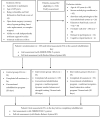Effects of Different Exercise Interventions on Fall Risk and Gait Parameters in Frail Patients After Open Heart Surgery: A Pilot Study
- PMID: 40005323
- PMCID: PMC11857756
- DOI: 10.3390/medicina61020206
Effects of Different Exercise Interventions on Fall Risk and Gait Parameters in Frail Patients After Open Heart Surgery: A Pilot Study
Abstract
Background and Objectives: Research on the effectiveness of different exercise programs on reducing fall risk and improving gait parameters among frail patients after open heart surgery is scarce. Therefore, the aim of this study was to evaluate and compare the effects of different exercise interventions on fall risk and gait parameters in frail patients after open heart surgery during inpatient rehabilitation. Materials and Methods: A prospective randomized study was conducted at Kulautuva Hospital of Rehabilitation, Hospital of Lithuanian University of Health Sciences Kauno Klinikos, from July 2021 to November 2023. A total of 105 pre-frail and frail patients were randomized into three groups: control (CG, n = 35), intervention 1 (IG-1, n = 35), and intervention 2 (IG-2, n = 35). All three groups completed a conventional rehabilitation program that included aerobic training tailored based on each person's health status six times/week. The IG-1 additionally received multicomponent dynamic aerobic balance and strength training three times/week, and the IG-2 received a combined computer-based interactive program three times/week. The overall stability index, as an outcome of fall risk, Short Physical Performance Battery (SPPB) score, and gait parameters (geometry, stance, and timing) were assessed before and after rehabilitation. Results: Of the 105 patients, 87 completed the study. The median age of the patients was 71 years (range: 65-88); 64.76% were male. After rehabilitation, within-group comparisons showed a significant improvement in the overall stability index, SPPB, and all phase gait parameters in all groups. Of all geometry gait parameters, none of the groups showed a significant improvement in step width, and foot rotation was significantly reduced only in the IG-2. All timing gait parameters improved in the CG and IG-2 after rehabilitation, while in the IG-1, only gait speed was significantly improved. Between-group comparisons after rehabilitation revealed significant differences in the overall stability index among the groups and in all phase gait parameters except for stance phase between the IG-1 and the IG-2. The greatest significant difference was documented for the double stance phase between the IG-1 and the IG-2, and the smallest was recorded for the single limb support phase. Significantly greater differences in step time and stride time were found in the IG-1 and the IG-2 than in the CG. Conclusions: All applied interventions were effective in reducing fall risk based on the overall stability index. However, interactive exercise interventions decreased fall risk based on the overall stability index by one-fifth as compared to the conventional rehabilitation program. The incorporation of interactive exercise interventions in rehabilitation resulted in improved double stance phase, stride time, and step time parameters, but did not have any effect on gait speed as compared to other exercise interventions.
Keywords: cardiac rehabilitation; computer-based interactive program; frailty; open heart surgery.
Conflict of interest statement
The authors declare no conflicts of interest.
Similar articles
-
Frailty and Different Exercise Interventions to Improve Gait Speed in Older Adults after Acute Coronary Syndrome.Medicina (Kaunas). 2021 Dec 9;57(12):1344. doi: 10.3390/medicina57121344. Medicina (Kaunas). 2021. PMID: 34946289 Free PMC article. Clinical Trial.
-
The impact of additional resistance and balance training in exercise-based cardiac rehabilitation in older patients after valve surgery or intervention: randomized control trial.BMC Geriatr. 2021 Jan 7;21(1):23. doi: 10.1186/s12877-020-01964-3. BMC Geriatr. 2021. PMID: 33413144 Free PMC article. Clinical Trial.
-
Square-stepping exercise in older inpatients in early geriatric rehabilitation. A randomized controlled pilot study.BMC Geriatr. 2024 Apr 10;24(1):326. doi: 10.1186/s12877-024-04932-3. BMC Geriatr. 2024. PMID: 38600478 Free PMC article. Clinical Trial.
-
Multicomponent exercise and the hallmarks of frailty: Considerations on cognitive impairment and acute hospitalization.Exp Gerontol. 2019 Jul 15;122:10-14. doi: 10.1016/j.exger.2019.04.007. Epub 2019 Apr 14. Exp Gerontol. 2019. PMID: 30995516 Review.
-
Exercise Interventions for Preventing Falls Among Older People in Care Facilities: A Meta-Analysis.Worldviews Evid Based Nurs. 2017 Feb;14(1):74-80. doi: 10.1111/wvn.12193. Epub 2016 Dec 16. Worldviews Evid Based Nurs. 2017. PMID: 27984675
References
-
- Ambrosetti M., Abreu A., Corrà U., Davos C.H., Hansen D., Frederix I., Iliou M.C., Pedretti R.F.E., Schmid J.-P., Vigorito C., et al. Secondary Prevention through Comprehensive Cardiovascular Rehabilitation: From Knowledge to Implementation. 2020 Update. A Position Paper from the Secondary Prevention and Rehabilitation Section of the European Association of Preventive Cardiology. Eur. J. Prev. Cardiol. 2021;28:460–495. doi: 10.1177/2047487320913379. - DOI - PubMed
-
- Ciumărnean L., Milaciu M.V., Negrean V., Orășan O.H., Vesa S.C., Sălăgean O., Iluţ S., Vlaicu S.I. Cardiovascular Risk Factors and Physical Activity for the Prevention of Cardiovascular Diseases in the Elderly. Int. J. Environ. Res. Public Health. 2021;19:207. doi: 10.3390/ijerph19010207. - DOI - PMC - PubMed
Publication types
MeSH terms
LinkOut - more resources
Full Text Sources
Medical


